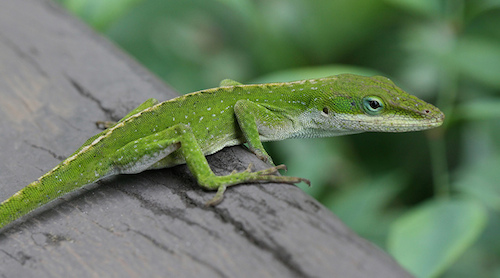 Evolution
Evolution
Since When Is This News? Rapid Microevolution in Lizard Feet Reveals Little About the Origin of Species

In 2009, the journal Nature came out with an online resource titled “15 Evolutionary Gems,” which was offered “for those wishing to spread awareness of evidence for evolution by natural selection.” Nature promoted the packet while “urg[ing] scientists and their institutions to ‘spread the word'” about evolution and “highlight reasons why scientists can treat evolution by natural selection as, in effect, an established fact.” But of course all of the verified examples of evolution among the evolutionary gems amounted only to micro- not macroevolution.
For example, one study they touted placed Anolis lizards under artificially created selective pressures. The lizards were found to undergo selection for both larger body sizes (in females) and longer limbs (in males), because this allowed them to better escape predatory “curly-tailed” lizards. And Anolis lizards may be small but they aren’t stupid: they also started spending less time on the ground and perched higher up in trees to escape their new predators. It’s an interesting study — but what does it say about the origin of lizards? Not much.
Now, a new paper in Science, “Rapid evolution of a native species following invasion by a congener, reports more small-scale changes in Anolis lizards as if they show something significant about the power of natural selection. One German news site calls it “Turbo-Evolution.” Here’s what the paper’s abstract says:
In recent years, biologists have increasingly recognized that evolutionary change can occur rapidly when natural selection is strong; thus, real-time studies of evolution can be used to test classic evolutionary hypotheses directly. One such hypothesis is that negative interactions between closely related species can drive phenotypic divergence. Such divergence is thought to be ubiquitous, though well-documented cases are surprisingly rare. On small islands in Florida, we found that the lizard Anolis carolinensis moved to higher perches following invasion by Anolis sagrei and, in response, adaptively evolved larger toepads after only 20 generations. These results illustrate that interspecific interactions between closely related species can drive evolutionary change on observable time scales.
The paper even tries to address the old objection that we don’t observe evolution by stating, “[E]volutionary hypotheses about phenomena once thought to transpire on time scales too long for direct observation can be tested in real time while using replicated statistical designs.”
Well, what did they come up with? Much like the paper from the Nature packet, these scientists found that when a new species of lizards invaded another’s territory (in fact the new species was placed there intentionally by the researchers, meaning they weren’t quite studying “natural” selection), the old one sought higher ground. That seems like a smart thing to do. To go along with the new territory, they subsequently evolved “larger toepads (see here for a picture).
After reading this, what I really wanted to see was the precise sizes of the toepad and compare the changes. But alas that information is not in the paper. I tried downloading the supplemental materials but it’s not there either. So let’s assume that the toepad size changed a lot. What have we shown?
Not much. We’ve seen that the size of lizard feet can change in response to invaders’ driving a species to perch at higher levels in the trees. No new traits arose. Only the size of a pre-existing trait changed. Again, that’s interesting but such changes in the size of lizard feet do very little to explain the origin of lizards in the first place, even if these changes happen in just a few generations.
If we take seriously the statement from the authors that the modest results from this study can help test “evolutionary hypotheses about phenomena … on time scales too long for direct observation,” then that implies that over long periods you might be able to change the size of an organism or some of its body parts. Since when is that news?
